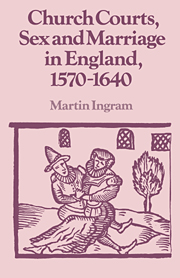Book contents
- Frontmatter
- Contents
- List of tables
- List of maps
- Preface
- Conventions and abbreviations
- Introduction
- PART 1 THE LEGAL AND SOCIAL BACKGROUND
- PART 2 SEX AND MARRIAGE: THE PATTERN OF PROSECUTIONS
- 5 Matrimonial causes: (i) the breakdown of marriage
- 6 Matrimonial causes: (ii) marriage formation
- 7 Prenuptial fornication and bridal pregnancy
- 8 Incest, adultery and fornication
- 9 Aiding and abetting sexual offences
- 10 Sexual slander
- PART 3 CHURCH COURTS AND SOCIETY
- Bibliography
- Index
- Past and Present Publications
5 - Matrimonial causes: (i) the breakdown of marriage
Published online by Cambridge University Press: 24 September 2009
- Frontmatter
- Contents
- List of tables
- List of maps
- Preface
- Conventions and abbreviations
- Introduction
- PART 1 THE LEGAL AND SOCIAL BACKGROUND
- PART 2 SEX AND MARRIAGE: THE PATTERN OF PROSECUTIONS
- 5 Matrimonial causes: (i) the breakdown of marriage
- 6 Matrimonial causes: (ii) marriage formation
- 7 Prenuptial fornication and bridal pregnancy
- 8 Incest, adultery and fornication
- 9 Aiding and abetting sexual offences
- 10 Sexual slander
- PART 3 CHURCH COURTS AND SOCIETY
- Bibliography
- Index
- Past and Present Publications
Summary
The pattern of matrimonial business dealt with by the ecclesiastical courts in late sixteenth- and early seventeenth-century England provides a telling index of differences between that society and the England of today. Nowadays the bulk of matrimonial litigation – no longer handled, of course, by the church courts, which lost their jurisdiction in this field in 1857 – relates to divorce. Four hundred years ago, the church's insistence on the indissolubility of marriage, and the relative stability of marriages in actual practice at most social levels, ensured that marital breakdown cases came much more rarely before the courts: far more common were marriage contract suits and other cases connected with the formation of marriage. Causes concerning separation, annulment and related matters were, however, regarded as of great gravity in ecclesiastical law, and in spite of their relatively small numbers were by no means devoid of social significance. It is the purpose of this chapter to assess the church courts' work in this field.
As was seen in Chapter 4, divorce in the modern sense was unrecognised, but erstwhile spouses could remarry if they managed to secure an annulment. But the grounds for action were narrowly defined, and indeed became even more restricted in the aftermath of the Reformation. Annulment also entailed drastic legal consequences, including the wife's loss of dower rights and the bastardising of any children born of the dissolved union. Furthermore, potential plaintiffs faced formidable problems of proof. All these factors conspired to minimise the numbers of cases brought before the courts.
- Type
- Chapter
- Information
- Church Courts, Sex and Marriage in England, 1570–1640 , pp. 171 - 188Publisher: Cambridge University PressPrint publication year: 1988



